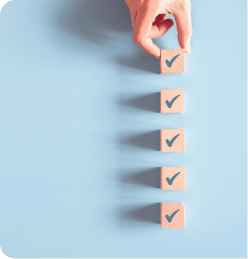By Kelley Voegelin, RYT
The journey to your wise years should be full of peace and insight. But it’s too often interrupted by symptoms like hot flashes, mood swings, irritability and anxiety. If that’s happening to you, use yoga to help relieve your menopausal symptoms!
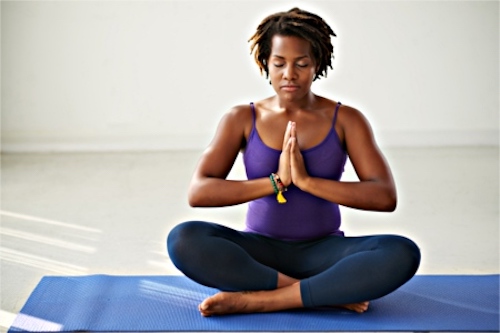
Here’s how yoga comes in and works. Menopause symptoms are triggered by the fluctuation of reproductive hormones and can be multiplied by stress. But three simple kinds of yoga postures can relieve menopausal symptoms and the build-up of stress that sets them off and makes them worse.
Yoga is your physical support in the midst of life’s biggest change
Yoga guides you on the path toward wellbeing by reducing stress, anxiety and fatigue — and reminding you that nothing in life is truly permanent. Practicing yoga allows you to stay present throughout the changes and challenges of menopause, and goes a long way to reduce the intensity of your symptoms.
Perhaps most important, the yoga process teaches you how to embrace compassion toward yourself. This ongoing gift can help you make the most of your menopause experience. And when you learn to incorporate it into your daily life, it will enrich everything that comes next.
The three types of yoga postures that help relieve menopausal symptoms of menopause are inversions, forward bends and reclining poses. Just remember to always aim for ease as opposed to struggle, which further ignites stress, heat and agitation.
1. Inversions: rebalance
When reproductive hormones drop, it can set off a chain reaction that your endocrine system tries to counterbalance. Inversions can help bring balance to the pituitary, pineal, hypothalamus, thyroid and adrenal glands. Inverted poses cool the brain and the body by drawing energy and heat from the skin back toward the body and organs. Inversions also pacify the nerves and balance moods.
Here are two inversions to try:
Downward Facing Dog (Adho Mukha Svanasana) puts your head below your heart to cool your emotions — and your temperature. Stand on the back of your mat and bend forward at the waist, bending your knees as much as necessary so your hands touch the mat. Gradually walk your hands forward until your body is in an inverted “V” shape, again with your knees bent as much as you want. Take several leisurely and full rounds of breath. To come out, either walk your hands back toward to feet or drop to your knees.
Legs-Up-The- Wall (Viparita Karani). Sit next a wall and, as you lie back, slide your legs up the wall. You may have to wiggle forward or backward to find a comfortable angle for your legs. You can use a folded blanket under the low back, or under the base of the skull, for support, or do the pose without it. Extend your arms alongside you, bend the elbows like a cactus, or rest the hands on the body. Stay for 5-10 minutes and breathe gently.
Note: Headstand (Sirsasana) and Shoulder Stand (Sarvangasana) are the king and queen of inversions, but might feel too challenging in menopause as they put pressure on the head or shoulders.
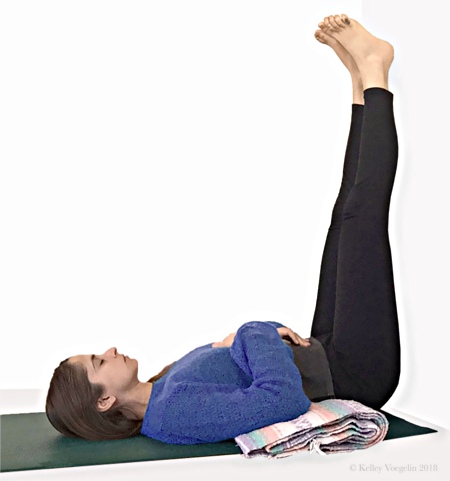
2. Forward bends: cool down
The intention of forward-bending postures is to cool, calm and pacify the body. This is a more internal shape that allows you to surrender, release, and soothe your mind by quieting mental chatter and releasing heat, anger, stress and anxiety. Because they cool your temperature and bring balance to the nervous system and adrenal glands, they can relieve insomnia, too. You can do forward bends while standing, lying or sitting. In standing forward folds, bend at the waist and place your hands on blocks to bring the ground closer to you.
Seated Forward Fold (Pascimottonasana). Sit with legs extended forward. Place a bolster, pillow or rolled blanket over the tops of your legs. Fold forward, resting your head on the bolster or your folded hands. Keep adding props (pillows, blankets, blocks) as needed until your head rests comfortably. Close your eyes and allow your exhales to lengthen slowly. Stay for several minutes.
Note: forward-bending poses can sometimes heighten depressed feelings. If this concerns you, skip folding forward and opt for a gentle reclining or heart-opening posture.
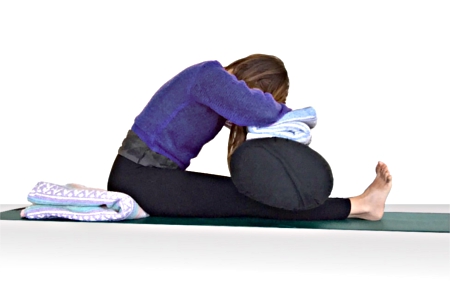
3. Reclining postures: restore
For many of us, supine shapes might be the best way to cool off, calm down, rest and re-center. While these positions create space and surrender within, they also subtly restore energy.
You can keep it simple and lie on your back in Corpse Pose (Savasana) for 10 minutes, allowing your breath to be easy and fluid. But you should at least try lying back over a bolster to create a gentle backbend and open the heart and lungs. What you’re after — and what you’ll get — depend on your intention and where you place the prop.
A block or bolster under the sacrum creates Restorative Bridge Pose.
Reclining Bound Angle (Supta Baddha Konasana). Sit on the floor with the soles of your feet touching, and knees fanned out wide; if this isn’t comfortable, place blocks or blankets underneath the knees to bring ease to the hips. Place a bolster a few inches behind your sacrum and lie back on it. Use a folded blanket to support the base of the head. Rest your arms beside you or place palms on the body. Stay for as long as you like. Breathe sweetly and deeply.
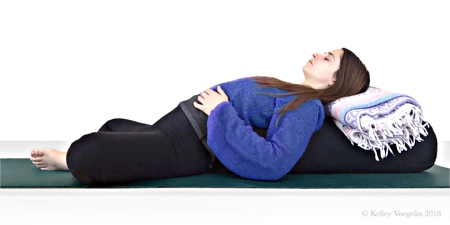
Yoga in menopause for awareness, meditation, honor
Allowing for your body to take the time it needs to travel through menopause helps liberate you from symptoms. Use these tips to help:
- Awareness of the process your body is following allows you to take note of what might set off a hot flash, a mood swing, a sleepless night. Be aware of how diet, bedtime, stressful situations — and even tight clothing — might trigger these symptoms.
- Meditation is a positive way to set the tone for your day and it helps you maintain clarity and perspective. At the end of the day, it serves as a means to clear your head of thoughts and worries that may keep you from a restful night’s sleep.
- Honor yourself. Be conscious and mindful of your true priorities, important commitments, known boundaries and restorative energies. Take time each day to reconnect with yourself in some way — be it with this yoga routine, quiet moments in meditation, journaling, or sharing your experience with other women who might also be traveling a similar path toward the second prime of her life.
 |
Want to get started with yoga and don’t know how? Try these 5 yoga poses for every body. |







